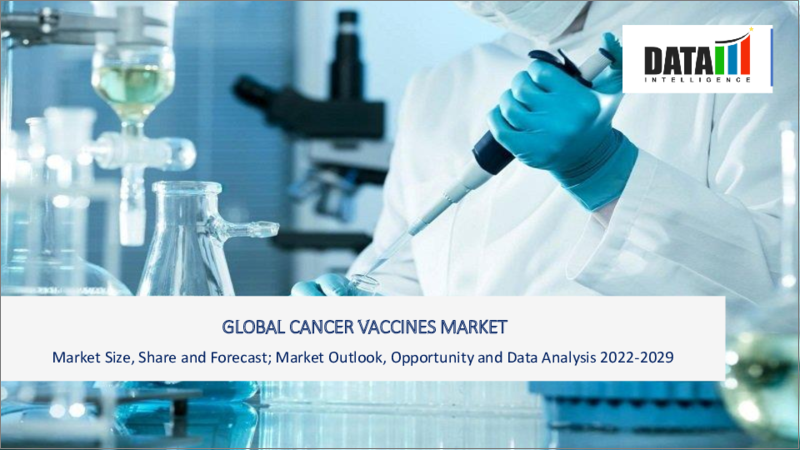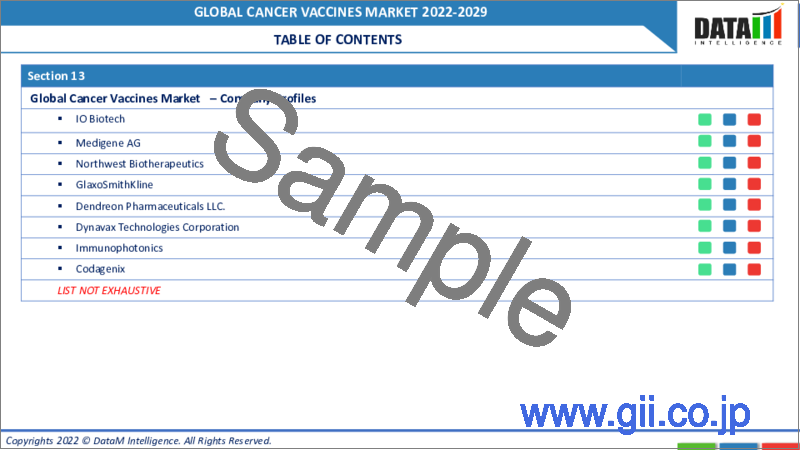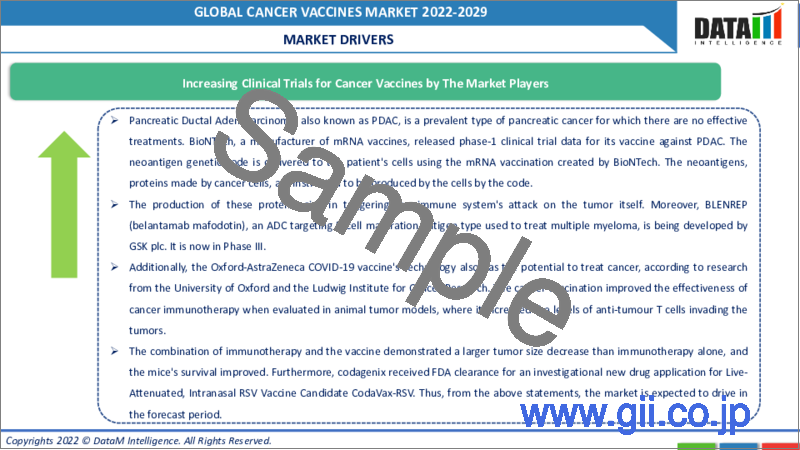|
|
市場調査レポート
商品コード
1138273
がんワクチンの世界市場-2022-2029Global Cancer Vaccines Market - 2022-2029 |
||||||
|
● お客様のご希望に応じて、既存データの加工や未掲載情報(例:国別セグメント)の追加などの対応が可能です。 詳細はお問い合わせください。 |
|||||||
| がんワクチンの世界市場-2022-2029 |
|
出版日: 2022年10月18日
発行: DataM Intelligence
ページ情報: 英文 180 Pages
納期: 約2営業日
|
- 全表示
- 概要
- 目次
市場力学
市場関係者によるがんワクチンの臨床試験の増加が、市場成長の原動力になると予想されます。
PDACとして知られる膵管腺癌は、有効な治療法がない膵臓癌の代表的なタイプです。mRNAワクチンのメーカーであるBioNTech社は、PDACに対するワクチンの第1相臨床試験データを発表しました。バイオNTech社が作成したmRNAワクチンを用いて、ネオアンチゲンの遺伝子コードを患者の細胞に送り込みます。がん細胞が作るタンパク質であるネオアンチゲンは、コードによって細胞で作られるよう指示されます。このタンパク質の産生が、腫瘍そのものに対する免疫系の攻撃の引き金となることを補助します。さらに、多発性骨髄腫の治療に用いられるB細胞成熟抗原型を標的としたADC、BLENREP(belantamab mafodotin)をGSK plcが開発中です。現在、第III相臨床試験中です。
さらに、オックスフォード大学とルートヴィヒがん研究所の調査によると、オックスフォード・アストラゼネカ社のCOVID-19ワクチンの技術は、がん治療にも応用できる可能性があるとのことです。このがんワクチン接種は、動物腫瘍モデルで評価した場合、がん免疫療法の効果を向上させ、腫瘍に侵入する抗腫瘍性T細胞のレベルを増加させます。また、免疫療法とワクチンの併用により、免疫療法単独よりも大きな腫瘍縮小効果を示し、マウスの生存率も向上しました。さらに、codagenix社は、弱毒性経鼻RSVワクチン候補であるCodaVax-RSVの治験薬申請をFDAに承認されました。このように、上記の記述から、予測期間において市場が牽引されることが予想されます。
制約事項
がんワクチンの開発コストが高いこと、1つのワクチンの製造に長い時間がかかること、規制当局の承認に時間がかかることなどが、予測期間中に市場が阻害される要因として予想されています。
産業分析
がんワクチン市場は、ポーターファイブフォース、アンメットニーズ、価格分析、サプライチェーン分析、規制分析など、様々な業界要因に基づく市場の詳細な分析を提供します。
COVID-19の影響分析
COVID-19のパンデミックは、市場に中程度の影響を与えています。COVID-19の症例数が増加するにつれ、世界中のヘルスケアシステムは病気のコントロールに注力し、癌を含む他の慢性疾患の予防、発見、治療を遅らせました。オックスフォード大学とAstraZeneca Plcの研究者は、同じ手法で治療用がんワクチンを作ろうとしており、動物実験では有望な結果が報告されています。パンデミック後、科学者と政府はウイルスを封じ込めるためのワクチン製造に、これまで以上に熱心に、そして迅速に取り組みました。その結果、ワクチン研究は進化を遂げました。この危機的状況から、メッセンジャーRNAのような技術は、その有効性と癌のような他の病気の治療への可能性を証明することになっています。研究者たちが、腫瘍と戦うために免疫系を利用する他の最先端の癌治療法を調査する中で、この進歩がもたらされたのです。
一方、パンデミックは、がんワクチンのサプライチェーンとプロセスを中断させます。このように、COVID-19のパンデミックは市場に影響を及ぼしています。しかし、この状況は予測期間中に徐々に改善されると予想されます。
世界のがんワクチン市場レポートでは、約45+市場データ表、40+図、180ページの構成で提供しています。
目次
第1章 調査手法と調査範囲
- 調査手法
- 調査目的および調査範囲
第2章 市場の定義と概要
第3章 エグゼクティブサマリー
第4章 市場の力学
- 市場影響要因
- 促進要因
- 市場参入企業によるがんワクチンの臨床試験の増加が市場成長を促進する見込み
- 抑制要因
- がんワクチン開発の高コストが市場成長の妨げになると予想されます。
- 機会
- 影響分析
第5章 産業分析
- サプライチェーン分析
- 価格設定分析
第6章 COVID-19の分析
- COVID-19の市場分析
- COVID-19以前の市場シナリオ
- COVID-19の現在の市場シナリオ
- COVID-19の後、または将来のシナリオ
- COVID-19の中での価格ダイナミクス
- 需要-供給スペクトラム
- パンデミック時の市場に関連する政府の取り組み
- メーカーの戦略的な取り組み
- まとめ
第7章 タイプ別
- 予防用がんワクチン
- 治療用がんワクチン
第8章 技術別
- 樹状細胞(DC)がんワクチン
- リコンビナントがんワクチン
- 抗原/アジュバントがんワクチン
- 全細胞型がんワクチン
- ウイルスベクターおよびDNAがんワクチン
第9章 がんタイプ別
- 前立腺癌
- 子宮頸がん
- 肺がん
- 膀胱癌
- その他
第10章 地域別
- 北米
- 米国
- カナダ
- メキシコ
- 欧州
- ドイツ
- 英国
- フランス
- イタリア
- スペイン
- その他欧州
- 南米
- ブラジル
- アルゼンチン
- その他の南米地域
- アジア太平洋地域
- 中国
- インド
- 日本
- オーストラリア
- その他アジア太平洋地域
- 中東・アフリカ地域
第11章 競合情勢
- 主な展開と戦略
- 企業シェア分析
- 製品ベンチマーク
- 注目の主要企業リスト
第12章 企業プロファイル
- ose-immuno
- 企業概要
- 製品ポートフォリオと説明
- 主なハイライト
- 財務概要
- Merck & Co. Inc.
- IO Biotech
- Medigene AG
- Northwest Biotherapeutics
- GlaxoSmithKline
- Dendreon Pharmaceuticals LLC.
- Dynavax Technologies Corporation
- Immunophotonics
- Codagenix(*LIST NOT EXHAUSTIVE)
第13章 DataM
Market Overview
Cancer vaccines market size was valued USD million in 2021 and is estimated to reach USD million by 2029, growing at a CAGR of 18% during the forecast period (2022-2029).
Cancer is a malignant tumor caused by uncontrollable cell development in the body. It can be treated with a variety of drugs and vaccinations. Vaccines are widely classified as either preventative or therapeutic. Preventive cancer vaccinations are used to prevent oncovirus-caused cancer and to protect against human papillomavirus (HPV), whereas therapeutic vaccines stimulate the individual adaptive immune systems by employing tumor antigens. Cancer vaccines are available in various forms, including antigen, dendritic cell, and anti-idiotype.There are several vaccines such as personalized cancer vaccines, anthrax vaccines, and other types of vaccines.
Market Dynamics
Increasing clinical trials for cancer vaccines by the market players is expected to drive market growth.
Pancreatic Ductal Adenocarcinoma, also known as PDAC, is a prevalent type of pancreatic cancer for which there are no effective treatments. BioNTech, a manufacturer of mRNA vaccines, released phase-1 clinical trial data for its vaccine against PDAC. The neoantigen genetic code is delivered to the patient's cells using the mRNA vaccination created by BioNTech. The neoantigens, proteins made by cancer cells, are instructed to be produced by the cells by the code. The production of these proteins aids in triggering the immune system's attack on the tumor itself. Moreover, BLENREP (belantamab mafodotin), an ADC targeting B-cell maturation antigen type used to treat multiple myeloma, is being developed by GSK plc. It is now in Phase III.
Additionally, the Oxford-AstraZeneca COVID-19 vaccine's technology also has the potential to treat cancer, according to research from the University of Oxford and the Ludwig Institute for Cancer Research. The cancer vaccination improved the effectiveness of cancer immunotherapy when evaluated in animal tumor models, where it increased the levels of anti-tumour T cells invading the tumors. The combination of immunotherapy and the vaccine demonstrated a larger tumor size decrease than immunotherapy alone, and the mice's survival improved. Furthermore, codagenix received FDA clearance for an investigational new drug application for Live-Attenuated, Intranasal RSV Vaccine Candidate CodaVax-RSV. Thus, from the above statements, the market is expected to drive in the forecast period.
Restraint:
The high cost of developing cancer vaccines, the longer time required for manufacturing a single vaccine and lengthy regulatory approvals are some factors the market is expected to get hampered in the forecast period.
Industry Analysis
The cancer vaccines market provides in-depth analysis of the market based on various industry factors such as porter five forces, unmet needs, pricing analysis, supply chain analysis, regulatory analysis etc.
COVID-19 Impact Analysis
The COVID-19 pandemic has moderately impacted the market. As the number of COVID-19 cases increased, healthcare systems worldwide focused on controlling the illness and delaying the prevention, detection, and treatment of other chronic illnesses, including cancer. Researchers at the University of Oxford and AstraZeneca Plc are attempting to create a therapeutic cancer vaccine using the same technique, with encouraging findings reported in animal experiments. After the pandemic, scientists and governments worked harder and faster than ever to produce vaccines to help contain the virus. As a result, vaccine research has evolved. Because of the crisis, technologies like messenger RNA have proven their efficacy and potential to treat other diseases like cancer. The advancements come as researchers examine other cutting-edge cancer treatments that use the immune system to fight tumors.
In contrast, the pandemic interrupts the cancer vaccine supply chain and process. Thus, the COVID-19 pandemic has affected the market. However, the situation is expected to improve gradually in the forecast period.
Segment Analysis
Recombinant Cancer Vaccines segment is expected to hold the largest market share in the cancer vaccine market.
The recombinant cancer vaccines segment is expected to dominate in 2021. Recombinant vaccines are created using recombinant DNA technology. This involves the expression of an antigen in mammalian cells, which triggers an immunological response and purifies the antigen from these cells. Various viruses have undergone genetic modification to express tumor-associated antigens (TAA) for intramuscular or subcutaneous injection. Broad cell tropism, strong immunogenicity, and pre-existing neutralizing immunity, exclusively in those patients who received the vaccinia virus, are only a few advantageous characteristics of poxviruses as vectors for cancer vaccines (the smallpox vaccine). Canarypox, fowlpox, and vaccines have all been studied therapeutically for cancer vaccination.
Additionally, a great deal of research is being done on viral recombinant cancer vaccines, primarily for cancer vaccination, which may have favorable outcomes in the future. Therefore, it has increased the demand for recombinant cancer vaccines. Thus, from the above statements, the market segment is expected to hold the largest market share in the forecast period.
Geographical Analysis
North American region holds the largest market share of the global cancer vaccines market.
In 2021, North America accounted for the highest revenue share. The increasing prevalence of cancer, rising research investments, increasing clinical trials by the market players and regulatory approvals for cancer vaccines are the factors the market is driven by in the forecast period. For instance, according to the American Cancer Society, in 2021, an estimated 1.9 million new cancer cases will be diagnosed, and there will be 608,570 cancer deaths in the United States. In contrast, in 2022, roughly 1.9 million people will be diagnosed with cancer in the United States. An estimated 287,850 women and 2,710 men will be diagnosed with breast cancer, which makes it the most common cancer diagnosis. Prostate cancer is the leading cancer diagnosis among men and the second most common overall, with 268,490 expected cases. Lung and bronchus cancer is the third most common cancer diagnosis, with an estimated 236,740 new cases.
Moreover, the 2020 American Society of Clinical Oncology (ASCO) Annual Meeting was held from May 29-31, 2020. Gilead Sciences, Inc. and Kite, a Gilead Company, announced that nine abstracts from their immuno-oncology research and development program, including three oral presentations, have been accepted. Abstracts at ASCO will showcase Kite's industry-leading cell therapy portfolio and magrolimab, an experimental anti-CD47 monoclonal antibody created by Forty-Seven, Inc., which Gilead just purchased. Thus, from the above statements, the North American region accounted for the largest market share in the forecast period.
Competitive Landscape
Major key players in the cancer vaccines market are ose-immuno, Merck & Co. Inc., IO Biotech, Medigene AG, Northwest Biotherapeutics, GlaxoSmithKline, Dendreon Pharmaceuticals LLC., Dynavax Technologies Corporation, Immunophotonics, Codagenix.
Northwest Biotherapeutics Inc.:
Overview:
Northwest Biotherapeutics Inc. is a biotechnology company involved in developing cancer vaccines. The target is a broad range of solid-tumor cancers. A customized vaccination is created by the corporation using a patented manufacturing method. The product portfolio includes product candidates such as DCVax-L for patients with brain cancer, DCVax-Direct for direct injection into all forms of solid tumor malignancies that are incurable, and DCVax for late-stage ovarian cancer. The U.S. Food and Drug Administration have given approval for DCVax-Prostate, which is used to treat late-stage prostate cancer.
Product Portfolio:
DCVAX TECHNOLOGY: DCVax is a platform technology for delivering dendritic cell based therapeutic vaccines for various cancers, including glioblastoma multiforme (GBM).
The global cancer vaccines market report would provide an access to an approx. 45+market data table, 40+figures and 180pages.
Table of Contents
1. Methodology and Scope
- 1.1. Research Methodology
- 1.2. Research Objective and Scope of the Report
2. Market Definition and Overview
3. Executive Summary
4. Market Dynamics
- 4.1. Market Impacting Factors
- 4.1.1. Drivers
- 4.1.2. Increasing clinical trials for cancer vaccines by the market players is expected to drive market growth.
- 4.2. Restraints:
- 4.2.1. The high cost of developing cancer vaccines is expected to hamper the market growth.
- 4.3. Opportunity
- 4.4. Impact Analysis
5. Industry Analysis
- 5.1. Supply Chain Analysis
- 5.2. Pricing Analysis
6. COVID-19 Analysis
- 6.1. Analysis of Covid-19 on the Market
- 6.1.1. Before COVID-19 Market Scenario
- 6.1.2. Present COVID-19 Market Scenario
- 6.1.3. After COVID-19 or Future Scenario
- 6.2. Pricing Dynamics Amid Covid-19
- 6.3. Demand-Supply Spectrum
- 6.4. Government Initiatives Related to the Market During Pandemic
- 6.5. Manufacturers Strategic Initiatives
- 6.6. Conclusion
7. By Type
- 7.1. Introduction
- 7.1.1. Market Size Analysis, and Y-o-Y Growth Analysis (%), By Type
- 7.1.2. Market Attractiveness Index, By Type Segment
- 7.2. Preventive Cancer Vaccines*
- 7.2.1. Introduction
- 7.2.2. Market Size Analysis, US$ Million, 2020-2029 and Y-o-Y Growth Analysis (%), 2021-2029
- 7.3. Therapeutic Cancer Vaccine
8. By Technology
- 8.1. Introduction
- 8.1.1. Market Size Analysis, and Y-o-Y Growth Analysis (%), By Technology
- 8.1.2. Market Attractiveness Index, By Technology Segment
- 8.2. Dendritic Cells (DC) Cancer Vaccines*
- 8.2.1. Introduction
- 8.2.2. Market Size Analysis, US$ Million, 2020-2029 and Y-o-Y Growth Analysis (%), 2021-2029
- 8.3. Recombinant Cancer Vaccines
- 8.4. Antigen/Adjuvant Cancer Vaccines
- 8.5. Whole Cell Cancer Vaccines
- 8.6. Viral Vector & DNA Cancer Vaccines
9. By Cancer Type
- 9.1. Introduction
- 9.1.1. Market Size Analysis, and Y-o-Y Growth Analysis (%), By Cancer Type
- 9.1.2. Market Attractiveness Index, By Cancer Type Segment
- 9.2. Prostate Cancer*
- 9.2.1. Introduction
- 9.2.2. Market Size Analysis, US$ Million, 2020-2029 and Y-o-Y Growth Analysis (%), 2021-2029
- 9.3. Cervical Cancer
- 9.4. Lung Cancer
- 9.5. Bladder Cancer
- 9.6. Others
10. By Region
- 10.1. Introduction
- 10.1.1. Market Size Analysis, US$ Million, 2020-2029 and Y-o-Y Growth Analysis (%), 2021-2029, By Region
- 10.1.2. Market Attractiveness Index, By Region
- 10.2. North America
- 10.2.1. Introduction
- 10.2.2. Key Region-Specific Dynamics
- 10.2.3. Market Size Analysis, and Y-o-Y Growth Analysis (%), By Type
- 10.2.4. Market Size Analysis, and Y-o-Y Growth Analysis (%), By Technology
- 10.2.5. Market Size Analysis, and Y-o-Y Growth Analysis (%), By Cancer Type
- 10.2.6. Market Size Analysis, and Y-o-Y Growth Analysis (%), By Country
- 10.2.6.1. U.S.
- 10.2.6.2. Canada
- 10.2.6.3. Mexico
- 10.3. Europe
- 10.3.1. Introduction
- 10.3.2. Key Region-Specific Dynamics
- 10.3.3. Market Size Analysis, and Y-o-Y Growth Analysis (%), By Type
- 10.3.4. Market Size Analysis, and Y-o-Y Growth Analysis (%), By Technology
- 10.3.5. Market Size Analysis, and Y-o-Y Growth Analysis (%), By Cancer Type
- 10.3.6. Market Size Analysis, and Y-o-Y Growth Analysis (%), By Country
- 10.3.6.1. Germany
- 10.3.6.2. U.K.
- 10.3.6.3. France
- 10.3.6.4. Italy
- 10.3.6.5. Spain
- 10.3.6.6. Rest of Europe
- 10.4. South America
- 10.4.1. Introduction
- 10.4.2. Key Region-Specific Dynamics
- 10.4.3. Market Size Analysis, and Y-o-Y Growth Analysis (%), By Type
- 10.4.4. Market Size Analysis, and Y-o-Y Growth Analysis (%), By Technology
- 10.4.5. Market Size Analysis, and Y-o-Y Growth Analysis (%), By Cancer Type
- 10.4.6. Market Size Analysis, and Y-o-Y Growth Analysis (%), By Country
- 10.4.6.1. Brazil
- 10.4.6.2. Argentina
- 10.4.6.3. Rest of South America
- 10.5. Asia Pacific
- 10.5.1. Introduction
- 10.5.2. Key Region-Specific Dynamics
- 10.5.3. Market Size Analysis, and Y-o-Y Growth Analysis (%), By Type
- 10.5.4. Market Size Analysis, and Y-o-Y Growth Analysis (%), By Technology
- 10.5.5. Market Size Analysis, and Y-o-Y Growth Analysis (%), By Cancer Type
- 10.5.6. Market Size Analysis, and Y-o-Y Growth Analysis (%), By Country
- 10.5.6.1. China
- 10.5.6.2. India
- 10.5.6.3. Japan
- 10.5.6.4. Australia
- 10.5.6.5. Rest of Asia Pacific
- 10.6. Middle East and Africa
- 10.6.1. Introduction
- 10.6.2. Key Region-Specific Dynamics
- 10.6.3. Market Size Analysis, and Y-o-Y Growth Analysis (%), By Type
- 10.6.4. Market Size Analysis, and Y-o-Y Growth Analysis (%), By Technology
- 10.6.5. Market Size Analysis, and Y-o-Y Growth Analysis (%), By Cancer Type
11. Competitive Landscape
- 11.1. Key Developments and Strategies
- 11.2. Company Share Analysis
- 11.3. Product Benchmarking
- 11.4. List of Key Companies to Watch
12. Company Profiles
- 12.1. ose-immuno*
- 12.1.1. Company Overview
- 12.1.2. Product Portfolio and Description
- 12.1.3. Key Highlights
- 12.1.4. Financial Overview
- 12.2. Merck & Co. Inc.
- 12.3. IO Biotech
- 12.4. Medigene AG
- 12.5. Northwest Biotherapeutics
- 12.6. GlaxoSmithKline
- 12.7. Dendreon Pharmaceuticals LLC.
- 12.8. Dynavax Technologies Corporation
- 12.9. Immunophotonics
- 12.10. Codagenix(*LIST NOT EXHAUSTIVE)
13. DataM Intelligence
- 13.1. Appendix
- 13.2. About Us and Applications
- 13.3. Contact Us




